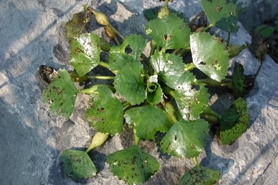Water chestnut
(Trapa natans)
Fast-growing, floating perennial herb. Cord-like plants can reach upwards of 16 ft. It exhibits excellent reproductive capacity, as it is an annual plant that overwinters entirely by seed. An individual seed can produce 10-15 rosettes, each having 15-20 seeds. Thus, one seed can give rise to 300 more new seeds in a year! This is not the same species as is used in Asian cooking.
Other names for this plant include:
- Common names: bull nut, European water chestnut, water nut
- Scientific names: T. natans var. natans; T. natans var. bisponosa; T. bisponosa
Classification in Wisconsin: Prohibited
- Ecological Threat
-
- It invades shallow to deep freshwater habitats in the northeastern United States.
- Dense floating mats restrict light availability, reduce the oxygen content and displace other emergent and floating vegetation. Limits boating, fishing, swimming and other recreational activities.
- Identification
-
Leaves: Upper leaves are alternately arranged in clusters up to 50 cm across, shiny on the upper side and dull with fine hairs underneath and diamond-shaped with toothed edges; submersed leaves are oppositely arranged, long and narrow, with green feather-like structures that often replace the linear underwater leaves. Upper leaves are attached to the stem with an inflated petiole, which keeps them afloat.
Flowers: Small and solitary, four white or light purple petals on short, thick stalks that float among the upper leaves; the four sepals turn into the spines of the fruit. It begins to flower in mid to late July.
Fruits & seeds: Large (2.5 cm), variously-shaped nuts are swollen in the middle and have 2-4 sharp spines. Each nut contains a single, fleshy seed. Mature nuts sink to the bottom when dropped and may be able to produce new plants for up to 12 years.
Roots: Develop on shoots. Lower roots are unbranched and thread-like, while upper roots are sparsely branched and fibrous.
Similar species: Trapa bispinosa is considered a variant of T. natans. The nuts have two to four short spines compared to the two large spines of T. natans.
- Distribution
-
Currently, there have been no reports of water chestnut in Wisconsin. Have you seen it? Please send us a report.
- Control
-
Mechanical: Manual or automated harvesting is effective at reducing larger populations and eradicating small populations.
Chemical: Aquatic-approved 2, 4-D has been an effective herbicide for control.
- Resources
- Sources for content:
- Czarapata, Elizabeth; Invasive Plants of the Upper Midwest: an illustrated guide to their identification and control. The University of Wisconsin Press. 2005. Pg. 148
- Center for Invasive Species and Ecosystem Health, Invasive.org. Last updated on May 4, 2010. Water Chestnut.
- Washington State Department of Ecology: Trapa natans [exit DNR]
- New Hampshire Department of Environmental Services. Environmental Factsheet WD-BB-43. Water Chestnut Discovered in New Hampshire Waters [exit DNR]
- Global Invasive Species Database: Trapa natans [exit DNR]. Last updated Sept. 28, 2005.



